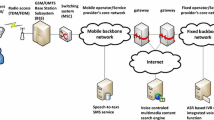Abstract
Jitter buffer plays an important role in Voice over IP (VoIP) applications because it provides a key mechanism for achieving good speech quality to meet technical and commercial requirements. The main objective of this paper is to propose a new, simple-to-use jitter buffer algorithm as a front-end to conventional static or adaptive jitter buffer algorithms to provide improved performance, in terms of enhanced user-perceived speech quality and reduced end-to-end delay. Supported by signal processing features, the new algorithm, the so-called Play Late Algorithm, alters the playout delay inside a speech talkspurt without introducing unnecessary extra end-to-end delay. The results show that the new algorithm achieves the best performance under different network conditions when compared to conventional static and adaptive jitter buffer algorithms. The results reported here are based on live tests and emulated network conditions on real mobile phone prototypes. The mobile phone prototypes use AMR codec and support full IP/UDP/RTP stack with IPSec function in some of the tests. The method for perceived speech quality measurement is based on the ITU-T standard for speech quality evaluation (PESQ).
Similar content being viewed by others
References
European Telecommunications Standards Institute. (1999). Specification and measurement of speech transmission quality; Part 1: Introduction to objective comparison measurement methods for one-way speech quality across networks. ETSI Guide, EG 201 377–1 V1.1.1, April 1999.
Yamamoto, L., & Beerends, J. G. (1997). Impact of network performance parameters on the end-to-end perceived speech quality. In Proceedings of Expert ATM Traffic Symposium. Mykonos, Greece, Sep. 1997.
International Telecommunication Union. (1996). Methods for subjective determination of transmission quality. ITU Recommendation P.800, August 1996.
International Telecommunication Union. (2001). Perceptual evaluation of speech quality (PESQ), an objective method for end-to-end speech quality assessment of narrowband telephone networks and speech codecs. ITU-T Recommendation P.862, Feb. 2001.
International Telecommunication Union. (2003). Mapping function for transforming P.862 raw result scores to MOS-LQO. ITU-T Recommendation P.862.1, Nov. 2003
Moon S.B., Kurose J., Towsley D. (1998). Packet audio playout delay adjustment: performance bounds and algorithms. ACM/Spring Multimedia Systems 5:17–28
Ramjee, R., Kurose, J., Towsley, D. & Schulzrinne, H. (1994). Adaptive playout mechanism for packetised audio application in wide-area networks. IEEE INFOCOM, Toronto, Canada.
Kramer, Kris W., Forrester, Chris C., et al. (2003). Jitter buffer management. US patent, US 6,658,027 B1, Dec 2003.
Liu, F., Kim, J., Kuo, C.-C. J. (2001). Adaptive delay concealment for Internet voice applications with packet-based time-scale modification. In IEEE International Conference on Acoustics Speech and Signal Processing, Proceedings of ICASSP 01 (vol. 3, pp. 1461–1464). May 2001.
Liang Y.J., Färber N., Girod B. (2003). Adaptive playout scheduling and loss concealment for voice communication over IP networks. IEEE Transactions on Multimedia 5(4):532–543
Sun, L., & Ifeachor, E. (2004). New models for perceived voice quality prediction and their applications in playout buffer optimization for VoIP networks. In Proceedings of IEEE International Conference on Communications (IEEE ICC 2004). Paris, France, June 2004.
European Telecommunications Standards Institute. (2000). Digital Cellular Telecommunications System (Phase 2+); Adaptive Multi-Rate (AMR) speech transcoding. ETSI-EN-301–704 V7.2.1, April 2000.
Liu, E., Shen, G., et al. (2005). Self-adaptive jitter buffer adjustment method for packet-switched network. US patent application publication, US 2005/0058146A1, Mar, 2005.
Adrian Emmanuel Eckberg. (2003). Techniques for jitter buffer delay management. US patent application publication, US 2003/0202528A1, Oct. 2003.
Fujimoto, K., Ata, S. & Murata, M. (2004). Adaptive playout buffer algorithm for enhancing perceived quality of streaming applications. Telecommunication Systems, 25(3–4), Spinger.
Zafiropoulos, F., & Xydeas, C. S. (2003). Model based packet loss concealment for AMR coders. In Proceedings of the IEEE International Conference on Acoustics Speech and Signal Processing (vol. I, 112–115), April 2003.
NIST Internetworking Technology Group (ITG). (2003). NIST net—a linux-based network emulation tool. Computer Communication Review, http://www.x.antd.nist.gov/nistnet/.
Sun, L., & Wade, G., et al. (2001). Impact of packet loss location on perceived speech quality. In Proceedings of 2nd IP-Telephony Workshop (IPTEL ’01) (pp. 114–122). Columbia University, New York, 2–3 April, 2001.
Author information
Authors and Affiliations
Corresponding author
Rights and permissions
About this article
Cite this article
Qiao, Z., Venkatasubramanian, R.K., Sun, L. et al. A New Buffer Algorithm for Speech Quality Improvement in VoIP Systems. Wireless Pers Commun 45, 189–207 (2008). https://doi.org/10.1007/s11277-007-9408-7
Received:
Accepted:
Published:
Issue Date:
DOI: https://doi.org/10.1007/s11277-007-9408-7




